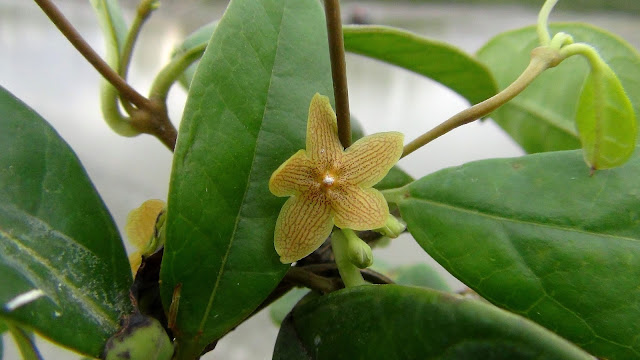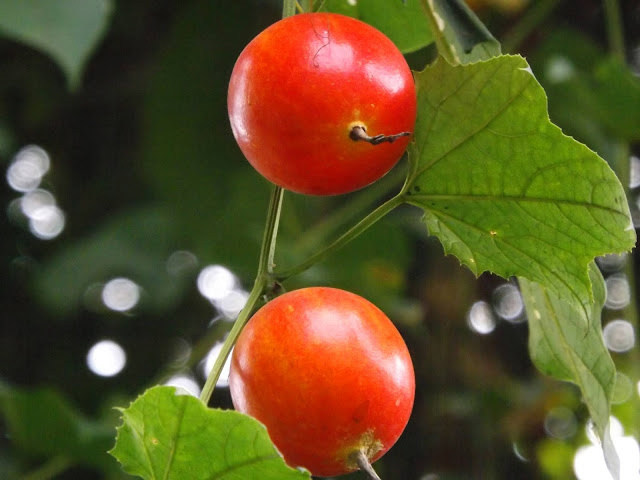Korpula or Bawali-lota, Sarcolobus carinatus
Korpula or Bawali-lota (Sarcolobus carinatus, Family: Asclepiadaceae) is a thin vine that twists a tree or trails on ground, having milky latex all over its body. The plant loves to grow the coastal tidal and salt-water forests.It is mainly found in the both sides of famous Mangrove forest Sundarbans, as well as the sea-shore of Noakhali, Bhola, Chattogram, Cox'sbazar districts. Outside the country, it is found in Indian subcontinent, Andaman-Nicobor Islands, China, Myanmar and Thailand.
Common names: Baoli-lota, Baoni-lota, Bandali-lota.
Its leaves are much like the shelterer tree Gewa or Blind your eye (Excoecaria agallocha). So suddenly it cannot be identified in isolation very easily. The leaves are about half as long as the leaves of the shelterer, similar in color. Presumably, the shelterer is the mother plant of the vine.
Leaves are pale green, obovate or elliptic-oblong, 3-6 cm long and 1-2 cm wide, coriacious, glabrous on both sides, apex acute or blunted, opposite. Leaves contain milky latex.
Flowers are in corymbose cyme inflorescence, 3-5 together. Starry-shaped flowers are bisexual, tiny, yellowish orange, petals 5, sepals 5, scentless. Flowering occurs in spring.
Fruit is a follicle, 5-7 cm long, ellipsoid, having the shape of Kamranga or Carambola, 5-6 divisions, with pointed and curved apex. The fruits are edible. Raw fruits are eaten by the locals frequently. These are dark green, ripe fruits reddish brown. The plant is propagated by seeds.
If the saltwater-native can survive in freshwater zone, it could be a great addition to the amateur garden. By the by, the plant is quite avoided in Bangla plant-literature.
There are another species, Sarcolobus globosus is very similar to this plant. These two species can be easily identified by their shape of the fruits. Its (Korpula) species name 'Carinatus' derives from the shape of fruit that looks like the bottom of the boat.
Its roots and follicles are used as fish poison. The plant is so elusive, even to botanists, its scientific name has changed repeatedly.
Synonyms: Sarcolobus banksiis, arcolobus beccarii, Sarcolobus borneensis, Sarcolobus brachystephanus, Sarcolobus ciliolatus, Sarcolobus globosus, Sarcolobus hullsii, Sarcolobus kaniensis, Sarcolobus lifuensis, Sarcolobus luzonensis, Sarcolobus merrillii, Sarcolobus minor, Sarcolobus multiflorus, Sarcolobus narcoticus, Sarcolobus oblongus, Sarcolobus pierrei, Sarcolobus porcatus, Sarcolobus quinquangularis, Sarcolobus retusus, Sarcolobus ritae, Sarcolobus rubescens, Sarcolobus secamonoides, Sarcolobus spanoghei, Sarcolobus spathulatus, Sarcolobus submucronatus, Sarcolobus subnudusa, Sarcolobus sulphureus, Sarcolobus venulosus, Sarcolobus virulentus, Sarcolobus vittatus, Sarcolobus warburgii.









Great Work Sir. Would love to see indigenous fruit section too!
ReplyDeleteদারুণ
ReplyDeleteবেশ ভালো হয়েছে
ReplyDeleteবেশ ভালো
ReplyDeleteসুন্দর !
ReplyDeleteঅসাধারণ
ReplyDelete